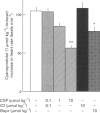Abstract
1. The influence of beta 1-, beta 2-, and beta 3-adrenoceptor agonists and of CGP 12177 and cyanopindolol on heart rate and diastolic blood pressure was studied in the pithed rat. 2. The beta 1-adrenoceptor agonist, prenalterol, increased heart rate and the beta 2-adrenoceptor agonist, fenoterol, caused a fall in blood pressure. The effect of prenalterol was antagonized by the beta 1-adrenoceptor antagonist, CGP 20712 0.1 mumol kg-1 and the action of fenoterol was attenuated by the beta 2-adrenoceptor antagonist, ICI 118551 0.1 mumol kg-1. Both effects were markedly diminished by the non-selective beta-adrenoceptor antagonist, bupranolol 0.1 mumol kg-1. 3. The non-selective beta-adrenoceptor agonist, isoprenaline, three beta 3-agonists as well as CGP 12177 and cyanopindolol elicited a positive chronotropic effect, exhibiting the following pED delta 60 values (negative log values of the doses increasing heart rate by 60 beats min-1): isoprenaline 10.4, CGP 12177 8.3, cyanopindolol 7.2, BRL 37344 6.9, ZD 2079 5.2 and CL 316243 < 5. 4. CGP 20712 0.1 mumol kg-1, given together with ICI 118551 0.1 mumol kg-1, markedly attenuated the positive chronotropic effect of isoprenaline, BRL 37344, ZD 2079 and CL 316243 without affecting the increase in heart rate produced by CGP 12177 and cyanopindolol. 5. The positive chronotropic effect of CGP 12177 and cyanopindolol was attenuated by CGP 20712, 1 and 10 mumol kg-1 and bupranolol, 10 mumol kg-1 but was not affected by ICI 118551, 10 mumol kg-1. The effect of CGP 12177 was also not changed by BRL 37344 1 mumol kg-1, ZD 2079 10 mumol kg-1, CL 316243 10 mumol kg-1, the alpha 1-adrenoceptor antagonist, prazosin 1 mumol kg-1 and the 5-hydroxytryptamine 5-HT2A receptor antagonist, ketanserin 3 mumol kg-1. 6. CGP 12177 0.002 mumol kg-1 and cyanopindolol 0.003 mumol kg-1 shifted to the right the dose-response curve of prenalterol for its positive chronotropic effect. The -log values of the doses causing a twofold shift to the right were 9.6 and 9.5, respectively. 7. Isoprenaline 0.00001-0.001 mumol kg-1, BRL 37344 0.01-1 mumol kg-1 and CGP 12177 0.1 mumol kg-1 caused a fall in diastolic blood pressure which was markedly attenuated by combined administration of CGP 20712 and ICI 118551, 0.1 mumol kg-1 each. 8. CGP 12177 0.01 and 0.1 mumol kg-1 and cyanopindolol 1 mumol kg-1 elicited an increase in diastolic blood pressure. CGP 20712, ICI 118551, bupranolol and, in the case of CGP 12177, also BRL 37344, ZD 2079, CL 316243, prazosin and ketanserin did not influence this effect. 9. In conclusion, the positive chronotropic effect of CGP 12177 and cyanopindolol is not mediated via beta 1-, beta 2-, beta 3-, alpha 1-adrenoceptors or 5-HT2A receptors. This effect may involve atypical beta-adrenoceptors, similar or identical to those described by Kaumann (1989) in isolated heart preparations.
Full text
PDF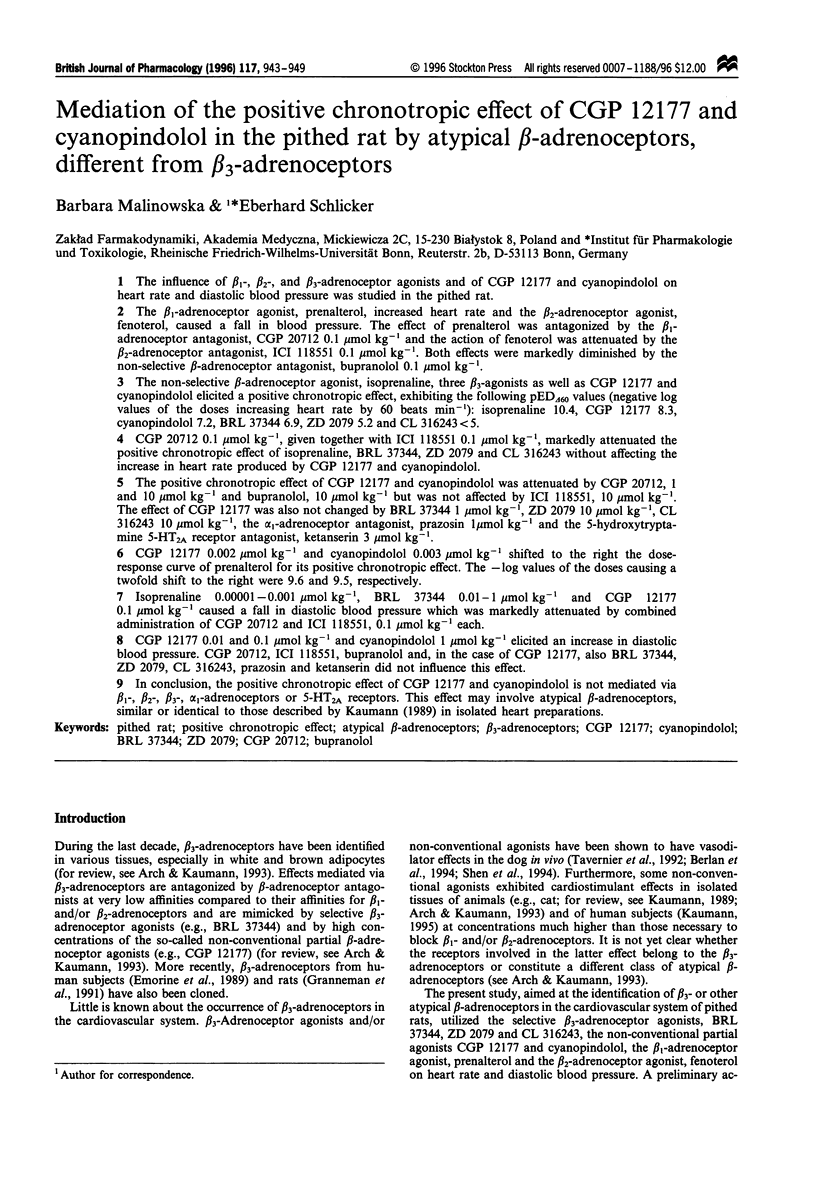
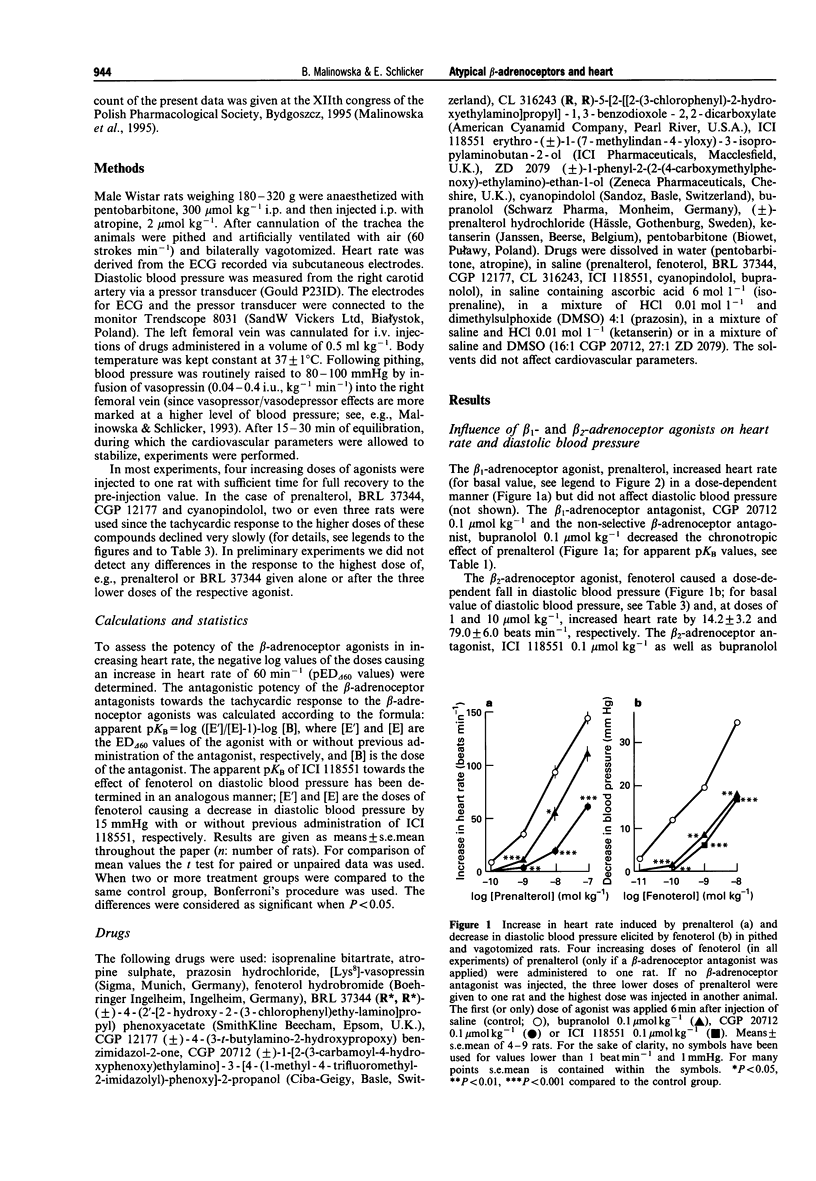

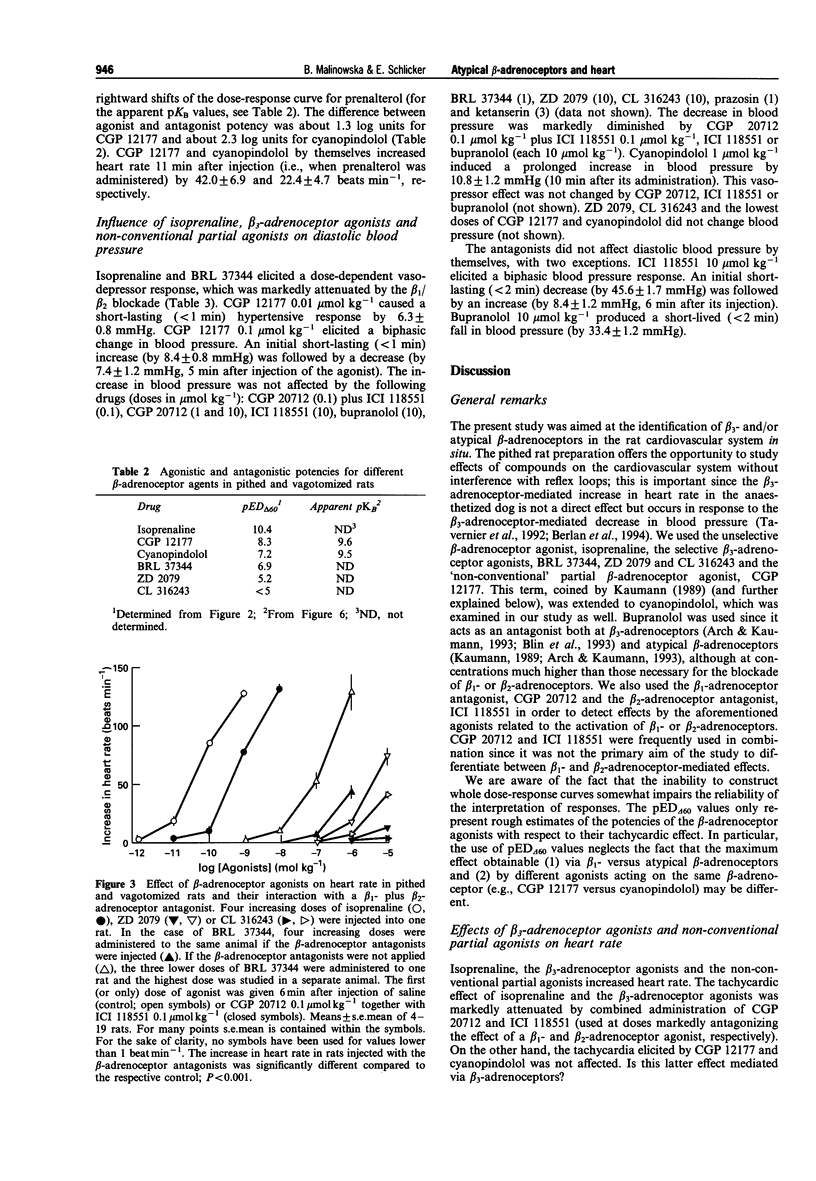
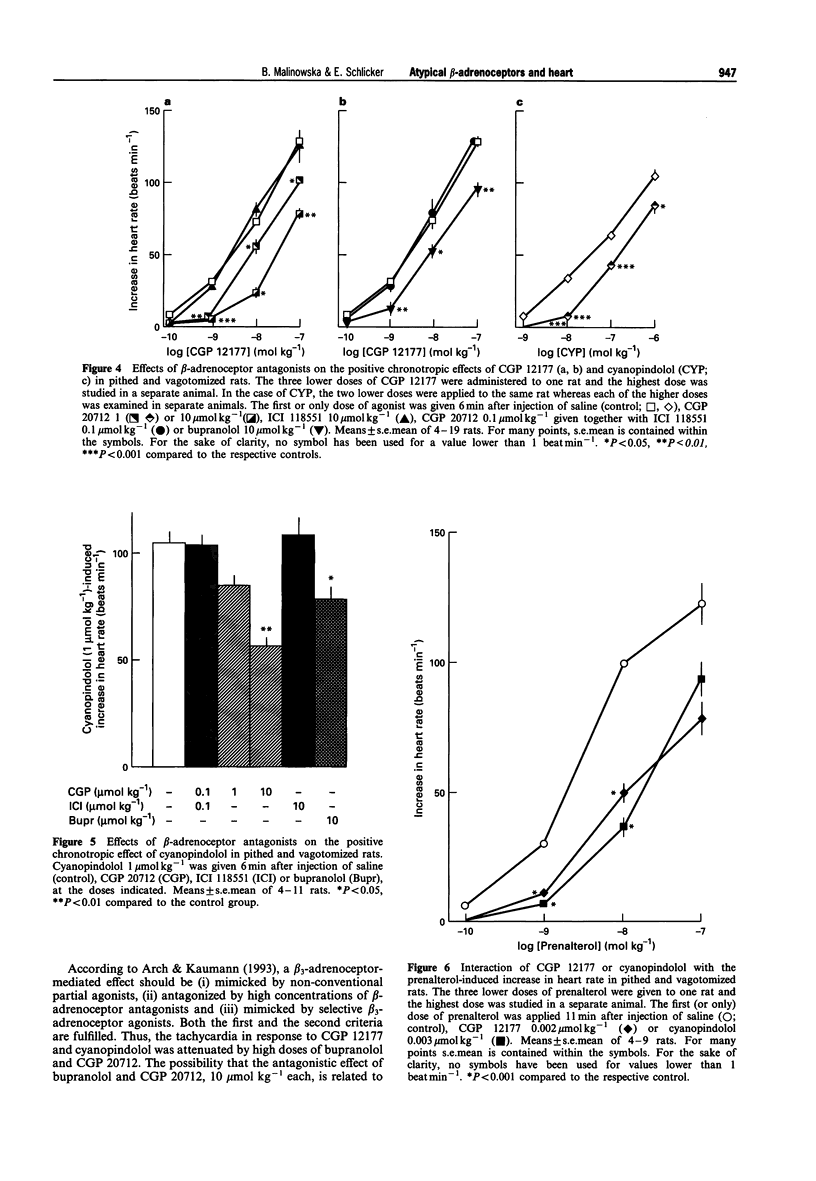

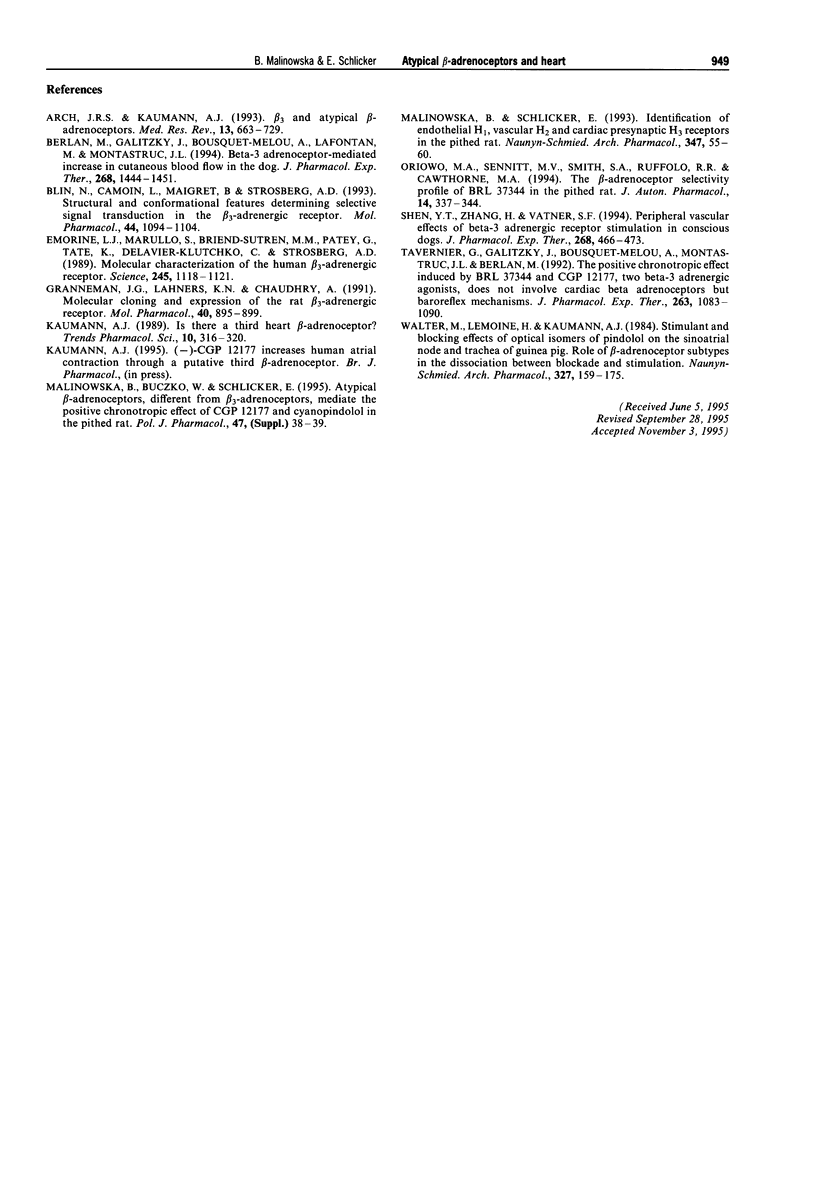
Images in this article
Selected References
These references are in PubMed. This may not be the complete list of references from this article.
- Arch J. R., Kaumann A. J. Beta 3 and atypical beta-adrenoceptors. Med Res Rev. 1993 Nov;13(6):663–729. doi: 10.1002/med.2610130604. [DOI] [PubMed] [Google Scholar]
- Berlan M., Galitzky J., Bousquet-Melou A., Lafontan M., Montastruc J. L. Beta-3 adrenoceptor-mediated increase in cutaneous blood flow in the dog. J Pharmacol Exp Ther. 1994 Mar;268(3):1444–1451. [PubMed] [Google Scholar]
- Blin N., Camoin L., Maigret B., Strosberg A. D. Structural and conformational features determining selective signal transduction in the beta 3-adrenergic receptor. Mol Pharmacol. 1993 Dec;44(6):1094–1104. [PubMed] [Google Scholar]
- Emorine L. J., Marullo S., Briend-Sutren M. M., Patey G., Tate K., Delavier-Klutchko C., Strosberg A. D. Molecular characterization of the human beta 3-adrenergic receptor. Science. 1989 Sep 8;245(4922):1118–1121. doi: 10.1126/science.2570461. [DOI] [PubMed] [Google Scholar]
- Granneman J. G., Lahners K. N., Chaudhry A. Molecular cloning and expression of the rat beta 3-adrenergic receptor. Mol Pharmacol. 1991 Dec;40(6):895–899. [PubMed] [Google Scholar]
- Kaumann A. J. Is there a third heart beta-adrenoceptor? Trends Pharmacol Sci. 1989 Aug;10(8):316–320. doi: 10.1016/0165-6147(89)90065-5. [DOI] [PubMed] [Google Scholar]
- Malinowska B., Schlicker E. Identification of endothelial H1, vascular H2 and cardiac presynaptic H3 receptors in the pithed rat. Naunyn Schmiedebergs Arch Pharmacol. 1993 Jan;347(1):55–60. doi: 10.1007/BF00168772. [DOI] [PubMed] [Google Scholar]
- Oriowo M. A., Sennitt M. V., Smith S. A., Ruffolo R. R., Jr, Cawthorne M. A. The beta-adrenoceptor selectivity profile of BRL 37344 in the pithed rat. J Auton Pharmacol. 1994 Oct;14(5):337–344. doi: 10.1111/j.1474-8673.1994.tb00614.x. [DOI] [PubMed] [Google Scholar]
- Shen Y. T., Zhang H., Vatner S. F. Peripheral vascular effects of beta-3 adrenergic receptor stimulation in conscious dogs. J Pharmacol Exp Ther. 1994 Jan;268(1):466–473. [PubMed] [Google Scholar]
- Tavernier G., Galitzky J., Bousquet-Melou A., Montastruc J. L., Berlan M. The positive chronotropic effect induced by BRL 37344 and CGP 12177, two beta-3 adrenergic agonists, does not involve cardiac beta adrenoceptors but baroreflex mechanisms. J Pharmacol Exp Ther. 1992 Dec;263(3):1083–1090. [PubMed] [Google Scholar]
- Walter M., Lemoine H., Kaumann A. J. Stimulant and blocking effects of optical isomers of pindolol on the sinoatrial node and trachea of guinea pig. Role of beta-adrenoceptor subtypes in the dissociation between blockade and stimulation. Naunyn Schmiedebergs Arch Pharmacol. 1984 Sep;327(2):159–175. doi: 10.1007/BF00500912. [DOI] [PubMed] [Google Scholar]



